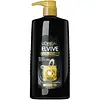What's inside
What's inside
 Key Ingredients
Key Ingredients

 Benefits
Benefits

 Concerns
Concerns

 Ingredients Side-by-side
Ingredients Side-by-side

Water
Skin ConditioningCetearyl Alcohol
EmollientAmodimethicone
Behentrimonium Methosulfate
Behentrimonium Chloride
PreservativeParfum
MaskingDipropylene Glycol
HumectantPhenoxyethanol
PreservativeBenzoic Acid
MaskingTrideceth-6
EmulsifyingPrunus Amygdalus Dulcis Oil
Skin ConditioningHydroxypropyl Guar
Emulsion StabilisingLinalool
PerfumingPotassium Hydroxide
BufferingGlycerin
HumectantBenzyl Salicylate
PerfumingBenzyl Alcohol
PerfumingCetrimonium Chloride
AntimicrobialLimonene
PerfumingHydroxypropyltrimonium Hydrolyzed Wheat Protein
Skin ConditioningAmyl Cinnamal
PerfumingCoumarin
PerfumingCitronellol
Perfuming2-Oleamido-1,3-Octadecanediol
Skin ConditioningAlpha-Isomethyl Ionone
PerfumingArgilla
AbrasivePrunus Amygdalus Dulcis Fruit Extract
Skin ConditioningCI 19140
Cosmetic ColorantCI 15985
Cosmetic ColorantXanthan Gum
EmulsifyingCitric Acid
BufferingSorbic Acid
PreservativeWater, Cetearyl Alcohol, Amodimethicone, Behentrimonium Methosulfate, Behentrimonium Chloride, Parfum, Dipropylene Glycol, Phenoxyethanol, Benzoic Acid, Trideceth-6, Prunus Amygdalus Dulcis Oil, Hydroxypropyl Guar, Linalool, Potassium Hydroxide, Glycerin, Benzyl Salicylate, Benzyl Alcohol, Cetrimonium Chloride, Limonene, Hydroxypropyltrimonium Hydrolyzed Wheat Protein, Amyl Cinnamal, Coumarin, Citronellol, 2-Oleamido-1,3-Octadecanediol, Alpha-Isomethyl Ionone, Argilla, Prunus Amygdalus Dulcis Fruit Extract, CI 19140, CI 15985, Xanthan Gum, Citric Acid, Sorbic Acid
Water
Skin ConditioningStearyl Alcohol
EmollientDimethicone
EmollientBehenamidopropyl Dimethylamine
EmulsifyingSorbitol
HumectantGlycosyl Trehalose
Emulsion StabilisingParfum
MaskingBehenyl Pg-Trimonium Chloride
EmulsifyingLactic Acid
BufferingParaffin
PerfumingBis-Diglyceryl Polyacyladipate-2
EmollientHydrogenated Starch Hydrolysate
HumectantAmodimethicone
Behenyl Alcohol
EmollientMethylparaben
PreservativeAlcohol
AntimicrobialHydroxyethylcellulose
Emulsion StabilisingPhenyl Trimethicone
Skin ConditioningC12-14 Pareth-7
EmulsifyingOryza Sativa Germ Oil
EmollientBis-Isobutyl PEG-14/Amodimethicone Copolymer
Laureth-4
EmulsifyingButylene Glycol
HumectantLaureth-23
CleansingLaureth-9
EmulsifyingC12-14 Pareth-12
EmulsifyingCaramel
Cosmetic ColorantC12-14 Pareth-5
CleansingPEG-55 Stearate
CleansingSodium Benzoate
MaskingPhenoxyethanol
PreservativeGlutamic Acid
HumectantOryza Sativa Bran Oil
EmollientCitric Acid
BufferingSodium Salicylate
PreservativeCamellia Japonica Seed Extract
Skin ConditioningPrunus Yedoensis Leaf Extract
Skin ConditioningBelamcanda Chinensis Root Extract
Skin ConditioningOryza Sativa Bran Extract
Skin ConditioningTocopherol
AntioxidantOryza Sativa Extract
AbsorbentWater, Stearyl Alcohol, Dimethicone, Behenamidopropyl Dimethylamine, Sorbitol, Glycosyl Trehalose, Parfum, Behenyl Pg-Trimonium Chloride, Lactic Acid, Paraffin, Bis-Diglyceryl Polyacyladipate-2, Hydrogenated Starch Hydrolysate, Amodimethicone, Behenyl Alcohol, Methylparaben, Alcohol, Hydroxyethylcellulose, Phenyl Trimethicone, C12-14 Pareth-7, Oryza Sativa Germ Oil, Bis-Isobutyl PEG-14/Amodimethicone Copolymer, Laureth-4, Butylene Glycol, Laureth-23, Laureth-9, C12-14 Pareth-12, Caramel, C12-14 Pareth-5, PEG-55 Stearate, Sodium Benzoate, Phenoxyethanol, Glutamic Acid, Oryza Sativa Bran Oil, Citric Acid, Sodium Salicylate, Camellia Japonica Seed Extract, Prunus Yedoensis Leaf Extract, Belamcanda Chinensis Root Extract, Oryza Sativa Bran Extract, Tocopherol, Oryza Sativa Extract
Ingredients Explained
These ingredients are found in both products.
Ingredients higher up in an ingredient list are typically present in a larger amount.
This water-soluble silicone is used for its hydrating and softening properties. It is used to add a silky feel to skincare products and has great benefits for haircare.
In haircare, this ingredient:
- Adds shine
- Protects color
- Offers thermal protection
- Boosts hair strength
- Does not build up as easily
Citric Acid is an alpha hydroxy acid (AHA) naturally found in citrus fruits like oranges, lemons, and limes.
Like other AHAs, citric acid can exfoliate skin by breaking down the bonds that hold dead skin cells together. This helps reveal smoother and brighter skin underneath.
However, this exfoliating effect only happens at high concentrations (20%) which can be hard to find in cosmetic products.
Due to this, citric acid is usually included in small amounts as a pH adjuster. This helps keep products slightly more acidic and compatible with skin's natural pH.
In skincare formulas, citric acid can:
While it can provide some skin benefits, research shows lactic acid and glycolic acid are generally more effective and less irritating exfoliants.
Most citric acid used in skincare today is made by fermenting sugars (usually from molasses). This synthetic version is identical to the natural citrus form but easier to stabilize and use in formulations.
Read more about some other popular AHA's here:
Learn more about Citric AcidParfum is a catch-all term for an ingredient or more that is used to give a scent to products.
Also called "fragrance", this ingredient can be a blend of hundreds of chemicals or plant oils. This means every product with "fragrance" or "parfum" in the ingredients list is a different mixture.
For instance, Habanolide is a proprietary trade name for a specific aroma chemical. When used as a fragrance ingredient in cosmetics, most aroma chemicals fall under the broad labeling category of “FRAGRANCE” or “PARFUM” according to EU and US regulations.
The term 'parfum' or 'fragrance' is not regulated in many countries. In many cases, it is up to the brand to define this term.
For instance, many brands choose to label themselves as "fragrance-free" because they are not using synthetic fragrances. However, their products may still contain ingredients such as essential oils that are considered a fragrance by INCI standards.
One example is Calendula flower extract. Calendula is an essential oil that still imparts a scent or 'fragrance'.
Depending on the blend, the ingredients in the mixture can cause allergies and sensitivities on the skin. Some ingredients that are known EU allergens include linalool and citronellol.
Parfum can also be used to mask or cover an unpleasant scent.
The bottom line is: not all fragrances/parfum/ingredients are created equally. If you are worried about fragrances, we recommend taking a closer look at an ingredient. And of course, we always recommend speaking with a professional.
Learn more about ParfumPhenoxyethanol is a preservative that has germicide, antimicrobial, and aromatic properties. Studies show that phenoxyethanol can prevent microbial growth. By itself, it has a scent that is similar to that of a rose.
It's often used in formulations along with Caprylyl Glycol to preserve the shelf life of products.
Water. It's the most common cosmetic ingredient of all. You'll usually see it at the top of ingredient lists, meaning that it makes up the largest part of the product.
So why is it so popular? Water most often acts as a solvent - this means that it helps dissolve other ingredients into the formulation.
You'll also recognize water as that liquid we all need to stay alive. If you see this, drink a glass of water. Stay hydrated!
Learn more about Water